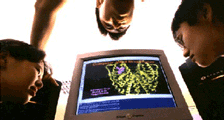



SMA5233/ CZ5206, Particle Methods and Molecular Dynamics (Elective, 4MC)
Synopsis
This module is intended for providing students with fundamental knowledge,
theoretical basis and numerical methods of modeling continuum, particle and molecular systems.
The topics include: Overview of the theory and algorithms that form the basis for molecular modeling at different
levels of approximation. Review of Monte Carlo and molecular dynamics simulation techniques: molecular mechanics
via empirical force field models. Energy minimization methods and conformational analysis. Quantum simulation
techniques. Introduction to simulation software, Application examples: structure phase transitions, surfaces,
protein simulation, and drug design.
Instructor
Dr. Chen Yu Zong
Department of Computational Science
National University of Singapore
Office: Blk S17 Room 07-24
Tel: 6874-6877. Fax: 6774-6756
E-mail: yzchen@cz3.nus.edu.sg
Web: http://www.cz3.nus.edu.sg/~yzchen
(Lots of info about
biocomputing)
Lectures and Projects in 2009/2010:
- Lectures:
- Part 1
- Lecture 1: Introduction
- Lecture 2: Physical Principles and Design Issues of MD
- Lecture 3: Force Fields
- Lecture 4: Integration Methods
- Lecture 5: Applications in Biomolecular Simulation and Drug Design
- Lecture 6: Coarse-grained hybrid MD
- Part 2
- Lecture 6, introduction to Monte Carlo method, random number generators
- Lecture 7, Some applications of MC method
- Lecture 8, Advanced MC methods, such as parallel tempering
- Lecture 9, Brownian dynamics, stochastic differential equations
- Lecture 10, dissipative particle method
- Lecture 11, smoothed particle hydrodynamics
- Project Assignments
and Exams:
- Projects
and labs of part 1 (24%):
- Molecular dynamics software (12%)
- Simulation of biomolecular motions and dynamics (12%)
- Exams (Part 1: 26%)
- Projects
and labs of part 1 (24%):
- Worload:
- Lecture hours per week: 2
- Laboratory hours per week: 2
- Number of hours per week for projects, fieldwork, assignments, etc. : 4
References:
Reference for part 1:
- "Molcular Modelling. Principles and Applications". Andrew Leach. Publisher: Prentice Hall. ISBN: 0582382106. This book has rapidly become the defacto introductory text for all aspects of simulation.
- "Molecular
Dynamics Simulation: Elementary Methods". J.M. Haile. Publisher:
Wiley. ISBN: 047118439X. This text provides a more focus but slightly
more old-fashioned view of simulation. It has some nice simple examples
of how to code (in fortran) some of the algorithms
P.W. Atkins Physical Chemistry (any edition) Chapters 11-14) - Schlick, T. Molecular Modeling and Simulation: An Interdisciplinary Guide. Springer-Verlag, New York, NY: 2002. ISBN 0-387-95404-X.
- MacKerell, A.D., Jr., Empirical Force Fields for Biological Macromolecules: Overview and Issues, Journal of Computational Chemistry, 25: 1584-1604, 2004
- M. P. Allen, D. J. Tildesley (1989) Computer simulation of liquids. Oxford University Press. ISBN 0198556454.
- J. A. McCammon, S. C. Harvey (1987) Dynamics of Proteins and Nucleic Acids. Cambridge University Press. ISBN 0-52-135652-0 (paperback); ISBN 0-52-130750 (hardback)
- D. C. Rapaport (1996) The Art of Molecular Dynamics Simulation. ISBN 0521445612. Daan Frenkel, Berend Smit (2001) Understanding Molecular Simulation. Academic Press. ISBN 0122673514
- J. M. Haile (2001) Molecular Dynamics Simulation: Elementary Methods. ISBN 047118439X
- Oren M. Becker, Alexander D. Mackerell Jr, Beno?t Roux, Masakatsu Watanabe (2001) Computational Biochemistry and Biophysics. Marcel Dekker. ISBN 082470455X
- Tamar Schlick (2002) Molecular Modeling and Simulation. Springer. ISBN 038795404X
Lectures and Projects in 2006/2007:
- Lectures:
- Part 1
- Lecture 1: Introduction
- Lecture 2: Physical Principles and Design Issues of MD
- Lecture 3: Force Fields
- Lecture 4: Integration Methods
- Lecture 5: Applications in Biomolecular Simulation and Drug Design
- Part 2
- Lecture 6, introduction to Monte Carlo method, random number generators
- Lecture 7, Some applications of MC method
- Lecture 8, Advanced MC methods, such as parallel tempering
- Lecture 9, Brownian dynamics, stochastic differential equations
- Lecture 10, dissipative particle method
- Lecture 11, smoothed particle hydrodynamics
- Project Assignments
and Exams:
- Projects and labs of part 1 (24%):
- Molecular dynamics software (12%)
- Simulation of biomolecular motions and dynamics (12%)
- Exams (Part 1: 26%)
- Projects and labs of part 1 (24%):
- Worload:
- Lecture hours per week: 2
- Laboratory hours per week: 2
- Number of hours per week for projects, fieldwork, assignments, etc. : 4
References:
Reference for part 1:
- "Molcular Modelling. Principles and Applications". Andrew Leach. Publisher: Prentice Hall. ISBN: 0582382106. This book has rapidly become the defacto introductory text for all aspects of simulation.
- "Molecular
Dynamics Simulation: Elementary Methods". J.M. Haile. Publisher:
Wiley. ISBN: 047118439X. This text provides a more focus but slightly
more old-fashioned view of simulation. It has some nice simple examples
of how to code (in fortran) some of the algorithms
P.W. Atkins Physical Chemistry (any edition) Chapters 11-14) - Schlick, T. Molecular Modeling and Simulation: An Interdisciplinary Guide. Springer-Verlag, New York, NY: 2002. ISBN 0-387-95404-X.
- MacKerell, A.D., Jr., Empirical Force Fields for Biological Macromolecules: Overview and Issues, Journal of Computational Chemistry, 25: 1584-1604, 2004
- M. P. Allen, D. J. Tildesley (1989) Computer simulation of liquids. Oxford University Press. ISBN 0198556454.
- J. A. McCammon, S. C. Harvey (1987) Dynamics of Proteins and Nucleic Acids. Cambridge University Press. ISBN 0-52-135652-0 (paperback); ISBN 0-52-130750 (hardback)
- D. C. Rapaport (1996) The Art of Molecular Dynamics Simulation. ISBN 0521445612. Daan Frenkel, Berend Smit (2001) Understanding Molecular Simulation. Academic Press. ISBN 0122673514
- J. M. Haile (2001) Molecular Dynamics Simulation: Elementary Methods. ISBN 047118439X
- Oren M. Becker, Alexander D. Mackerell Jr, Beno?t Roux, Masakatsu Watanabe (2001) Computational Biochemistry and Biophysics. Marcel Dekker. ISBN 082470455X
- Tamar Schlick (2002) Molecular Modeling and Simulation. Springer. ISBN 038795404X

 |
|
| about BIDD | databases | software | teaching | research | links | |